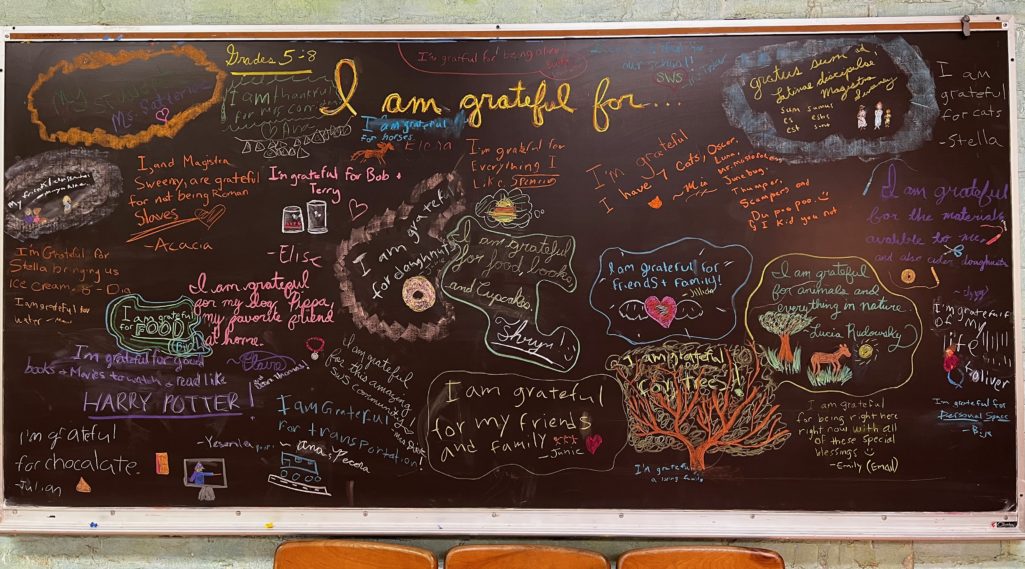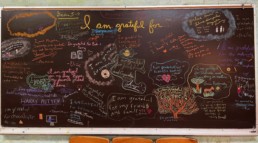Waldorf Education is the Education of the Future
Have you heard of “Bluey,” the most-streamed TV show of 2023, adored by critics and families alike? For anyone unfamiliar with it, it is an animated show from Australia depicting the life of a family of yes, dogs – a mother, father, and two daughters aged seven and five – Bluey and Bingo. Among the myriad of reasons why it has captivated children and their parents (who are often openly weeping while watching) is the enchanting school that Bluey attends – the Glasshouse Primary School. This school is based on an actual Steiner/Waldorf school. The creator of “Bluey,” Joe Brumm, stated in an interview with the website The Father Hood that Bluey’s school was inspired by his eldest daughter’s experience at school: “Play time was suddenly taken away from her, it was just yanked and seeing the difference in her was horrendous. There was no playing, there was no drawing, it was just straight into all this academic stuff. And the light in her eyes just died.’ The family subsequently changed their daughter’s schooling after Brumm began to research the value of play for child development. Mastering these soft kindergarten skills, he found, is a vital stage in kids’ evolution into socially aware creatures. Their make-believe games can deliver self-taught but powerful lessons about how to co-operate, share and interact. ‘Bluey is just one long extrapolation of that,’ Brumm says.”
As more and more parents are understanding the value of play-based learning, interest in Waldorf education for kindergarten and pre-K has increased. However, the value of continuing Waldorf education into the grades is less recognized. Common opinions of Waldorf education for older children are that it is too “woo-woo” for academic and career success, that it is mostly focused on arts and weak in math and science (despite the fact that more Waldorf high school graduates go on to major in math or sciences than humanities). As parents who, by definition, are of a previous generation than our children, we are informed by our own history of work and education. The schools we attended likely relied on standardized teaching and testing with outcomes such as grades and degrees as sole measures of achievement. Different areas of study such as sciences and humanities are so far separated as to constitute different cultures. “Soft skills” are still regarded with condescension in many workplaces. We can extend ourselves some grace when we believe that because this is the world in which we came up, this is the world for which we need to prepare our children.
However, according to the World Economic Forum (WEF), we are at the cusp of the Fourth Industrial Revolution. The First Industrial Revolution was driven by steam, the Second by electricity, and the Third by electronics and information technology. The Fourth is characterized by advanced analytics, intelligent computers, and connectivity, blurring the line between the physical and digital worlds. The rate of change in knowledge and technology is explosive, radically reshaping the jobs of the future and with them, the skills needed for these jobs. Traditional education based on knowledge acquisition and standardized tests only equips children with information that will become obsolete in a few short years without providing them the skills they actually need to adapt to change, or to take advantage of their uniquely human qualities that cannot be replaced by machines.
In its Future of Jobs Report 2023, the WEF states, “Analytical thinking and creative thinking remain the most important skills for workers in 2023. . . ahead of three self-efficacy skills – resilience, flexibility and agility; motivation and self-awareness; and curiosity and lifelong learning – in recognition of the importance of workers ability to adapt to disrupted workplaces.” In 2020, the WEF developed their Education 4.0 Framework to recognize changes needed in current education systems to equip children with the skills needed for the jobs of the future. They recommended eight transformations in content and learning experiences:
- Global citizenship skills – awareness of the global community and sustainability
- Innovation and creativity skills – complex problem solving, analytical thinking
- Technology skills – programming, responsible use of technology
- Interpersonal skills – emotional intelligence, empathy, cooperation, leadership, social awareness
- Personalized and self-paced learning – in contrast to standardized teaching and assessments
- Accessible and inclusive learning
- Problem-based and collaborative learning – process-based and collaborative work
- Lifelong and student-driven learning
The Organization for Economic Co-operation and Development’s (OECD) Future of Education and Skills 2030 report contains similar recommendations including a “focus on not only academic performance but also on holistic student well-being.”
Many of these points may feel familiar to those of us who have witnessed the education that our children receive at SWS. Rudolf Steiner, upon whose philosophy Waldorf education is based, stated, “The need for imagination, a sense of truth and a feeling of responsibility – these are the three forces which are the very nerve of education.” The system of education built on this recognition of the importance of creativity, social responsibility, and deep respect for our humanity, predates the WEF and OECD reports by over 100 years yet represents the education of the future. The WEF points out that legislators are slow to implement needed changes in education and highlights countries such as Finland (often rated to have the best education system in the world) as exemplars for other countries such as the US (which consistently ranks below European and Asian countries in math and science scores). We are fortunate that we do not have to rely on the glacial pace of government or move to another country to provide our children with an education that prepares them for future success.
Waldorf education is designed to be developmentally appropriate, experiential, and academically rigorous. By staying with a class for several years (a practice acknowledged as a contributing factor in Finland’s superior education system), teachers gain deep knowledge of each child and their development and therefore the ability to personalize each child’s learning experience. Developmental appropriateness includes Waldorf education’s choice to delay introducing electronics and media until children are able to think critically – to understand their appropriate use and to examine their benefits and risks in a way that promotes healthy and responsible interaction with technology. Researchers such as Jonathan Haidt in his recent book “The Anxious Generation” are recognizing the widespread damage that the decline in “play-based childhood” and the rise of “phone-based childhood” have inflicted on the mental health of our children. As technology reaches ever further into every aspect of our lives, educating children to become users who are critical, ethical, and deeply rooted in their humanity is an essential safeguard as artificial intelligence becomes more powerful.
Experiential learning – learning through doing – lays down and reinforces robust neural pathways as children create their own textbooks, access mathematical principles through music, or internalize lessons of history through art. Project-based learning, such as one recent example with my own child - building a model of a home from another culture, develops multiple skills at once. “Aptitudes are often abstract and therefore hard to teach in isolation. Effective teaching happens through a concrete case or real-world problem. This doesn’t only effectively nurture one skill but often develops multiple at once. This is highly useful in real-life and fosters lifelong learning.” - WEF Besides the traditional academic skills of identifying research material and incorporating information, my child tapped into his creativity and problem-solving skills by planning out his construction design and materials. He used his critical thinking and analytic skills to identify the cause of a structure failure. He cultivated empathy and social awareness in learning about the hardships and problems facing the group of people who lived in these abodes. And he learned valuable lessons in managing his own expectations and frustrations and his time. This “art project,” filled with fun and accomplishment, reinforced his experience of learning as rewarding and pleasurable, setting him up for a life-long love of learning.
As the Fourth Industrial Revolution already begins, we see that Waldorf graduates are well positioned to succeed. A 2019 report “How Waldorf Alumni Fare After Graduating from High School” shows that Waldorf graduates study or work in STEM fields at similar or higher rates than graduates of other independent schools. They feel more strongly than graduates of other independent schools that their education prepared them to be creative, innovative, empathetic, and to take on leadership roles. Fortunately, we do not need to rely on the uncertainty of public policy changes or move to Finland to give our children the education that they and our world need – it is already here, “for real life” as Bluey would say.
A Gratitude Note from Dr. Tom

As we enter this season of gratitude, I'm reminded of a poem written by a Waldorf teacher that begins with the two lines...
Home is where the heart is
So let this heart beat strong.
For the children in our care, home and school is the heart of their world. The support of our parents and the hard work of our teachers create a nurturing culture that we are grateful for at this time of Thanksgiving.
For our students, the heartbeat of the day starts with a greeting from a teacher, a rhythmical verse with classmates, and a measured song of reflective meaning. The challenge of the main lesson transcends memorization and recall to focus on the essence of learning: reflection, debate, understanding, and application. When I observe our dedicated teachers at work, I am thankful for their energy and talent to create authentic learning materials that challenge critical thinking and nurture self-discovery.
Susquehanna Waldorf's teachers are aware of society's influences on young people that can lead them to feel entitled to many things we can take for granted. Each teacher accepts the challenge by modeling reflective behavior and designing lessons that build awareness for all we have. How exciting to think about the impact of our grateful and resilient students will have on our future world! To borrow from the principles of Waldorf schools...
As an individual in society, our students are empowered to serve humanity with the strength of will, depth of feeling, clarity of thought, and the ability to work with others.
Thank you again for all your support of SWS. Have a warm and reflecting Thanksgiving!
Tom

